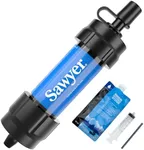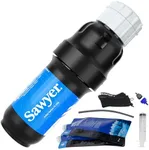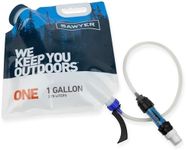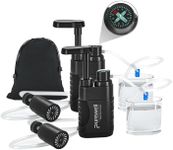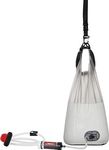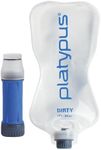Buying Guide for the Best Backpacking Water Filters
When choosing a backpacking water filter, it's important to consider the environment you'll be in, the number of people you'll be filtering water for, and the duration of your trip. A good water filter should effectively remove harmful pathogens and particulates from natural water sources, ensuring safe drinking water. The right filter for you will depend on factors like weight, ease of use, and the specific contaminants you need to filter out. Understanding the key specifications will help you make an informed decision that best suits your backpacking needs.Filtration TypeFiltration type refers to the method used to remove contaminants from water. Common types include pump filters, gravity filters, squeeze filters, and straw filters. This spec is important because it determines how you will use the filter and what kind of contaminants it can remove. Pump filters are versatile and can handle a variety of water sources, while gravity filters are great for filtering large volumes of water with minimal effort. Squeeze filters are lightweight and easy to use, making them ideal for solo backpackers, and straw filters are compact and best for personal use. Choose a filtration type based on your group size, water source, and personal preference for ease of use.
Filter Pore SizeFilter pore size indicates the size of the openings in the filter media, measured in microns. This spec is crucial because it determines the filter's ability to remove pathogens like bacteria and protozoa. Common pore sizes are 0.1 to 0.3 microns. A smaller pore size means better filtration but may result in slower water flow. For most backpacking needs, a pore size of 0.2 microns is sufficient to remove harmful bacteria and protozoa. If you're traveling in areas with known viral contamination, consider a filter with a smaller pore size or a purifier that can handle viruses.
Flow RateFlow rate measures how quickly water passes through the filter, usually expressed in liters per minute. This spec is important because it affects how long it will take to filter water, which can be crucial when you're on the move. Higher flow rates mean faster filtration, which is beneficial for groups or when time is limited. However, higher flow rates can sometimes mean less thorough filtration. Consider your patience level and group size when choosing a flow rate. Solo backpackers might be fine with a slower rate, while larger groups will benefit from a faster flow rate.
Weight and PackabilityWeight and packability refer to how heavy and compact the filter is when packed. This spec is important for backpackers who need to minimize their load. Lightweight and compact filters are ideal for long treks where every ounce counts. However, lighter filters may have limitations in terms of capacity and durability. Consider the length of your trip and your ability to carry extra weight when choosing a filter. If you're on a short trip or have a larger group to share the load, a slightly heavier filter with more features might be acceptable.
Filter LifespanFilter lifespan indicates how much water a filter can process before it needs to be replaced, usually measured in liters. This spec is important because it affects the long-term usability and cost-effectiveness of the filter. Longer lifespans mean less frequent replacements, which is beneficial for frequent backpackers. However, filters with longer lifespans may be more expensive upfront. Consider how often you plan to use the filter and the availability of replacement cartridges when choosing a filter lifespan. For occasional use, a shorter lifespan may be sufficient, while regular backpackers should opt for a longer lifespan.
